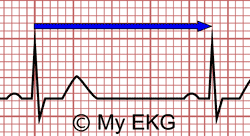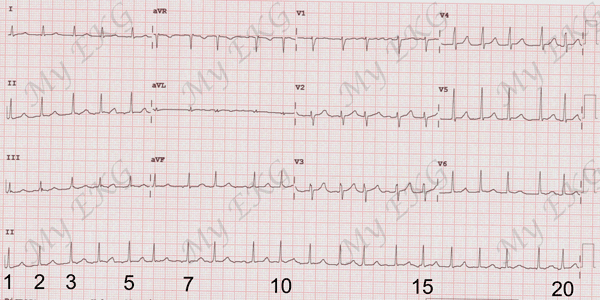How to Determine Heart Rate
The calculation of the heart rate of an electrocardiogram (EKG) is of great diagnostic importance, because determining a tachycardia or bradycardia may make us suspect certain pathologies and their severity.
The easiest way to calculate the heart rate is… to look for the value given by automated analysis of most electrocardiograms.
Are we kidding? No, many times this heart rate value is an actual one and speeds up the diagnostic process.
Anyway, every professional must know the different methods to calculate the heart rate, because not always the automatic analysis is real or there are electrocardiogram equipment that do not provide the value of the heart rate.
300, the Heart Rate Magic Number
On a normal electrocardiogram, there are five large squares per second and 300 per minute. Knowing this, we can calculate the heart rate measuring the R-R interval, providing the rhythm is regular.

Heart rate: 4 large square = 75 bpm
On the EKG, locate a R wave that matches a thick line, count the number of large squares to the next R wave. Heart rate is 300 divided by the number of large squares, and that’s it!
For example: if there is 1 large square between R waves, the heart rate is 300 bpm; two large squares, 150 bpm, three large squares, 100 bpm, four… 75 bpm.
What if the Second R Wave Does Not Match?
Do you think I have cheated and given you the most simple example?
We know that usually on an electrocardiogram strip the second R wave does not match a thick line. The solution is a little bit tricky, but simple: We divide 300 by the number of large squares + 0.2 per small square.

Heart rate: 4 large squares + 3 small square = 65 bpm
For example: If there are 4 large squares and 3 small squares between R waves, the heart rate is 65 bpm (300/4.6 = 65).
If you want to avoid the hassle, you can find a heart rate calculator in our calculations section to make it easy for you.
Heart Rate in Irregular Rhythms
The above options are only valid if the rhythm is regular. So…
How do we calculate HR is the rhythm is not regular, such as in atrial fibrillation? It may be even easier, like finger counting

Heart rate: 20 QRS complexes x 6 = 120 bpm
Usually electrocardiograms record 10 seconds, so all you have to do is count all QRS and multiply by 6.
If the EKG is not a 10 seconds one, or you are not aware of its duration, count 30 large squares (6 seconds), and multiply the number of QRS complexes on them by 10. The result is an approximate heart rate.
For example: Count the number of QRS complexes in 30 large squares (6 seconds) and multiply by 10. If there are 11 QRS complexes, the heart rate is 110 bpm (11 x 10= 110 bpm).
We hope we have been able to help you. For further details on heart rhythm analysis, click Next.
Tip: Before leaving, try our heart rate calculator.
previous | next
If you Like it... Share it.







